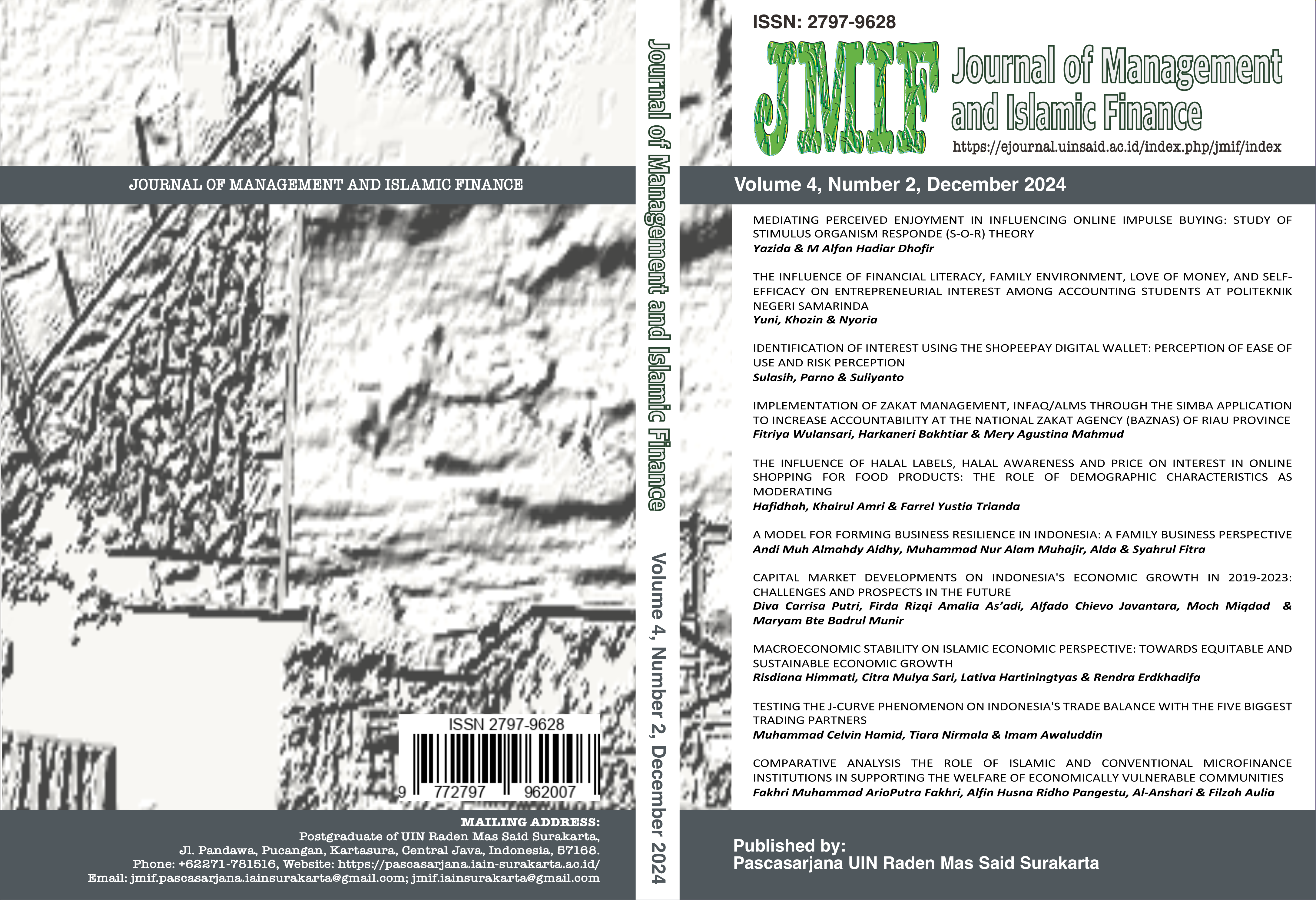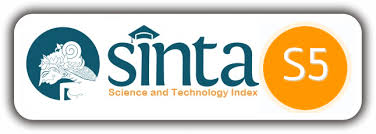TESTING THE J-CURVE PHENOMENON ON INDONESIA'S TRADE BALANCE WITH THE FIVE BIGGEST TRADING PARTNERS
DOI:
https://doi.org/10.22515/jmif.v4i2.9672Keywords:
J-Curve, Trade Balance, Real Exchange Rates, Export, ImportAbstract
Downloads
References
Acemoğlu, D., List, J., & Laibson, D. (2009). Macroeconomics. Erlangga.
Appleyard, D. R., & JR, A. J. F. . (2014). International Economics (8th ed.). McGraw-Hill/Irwin.
Bahmani-Oskooee, M., & Harvey, H. (2017). The J-curve and bilateral trade balances of Indonesia with its major partners: are there asymmetric effects? New Zealand Economic Papers, 53(1), 63–76. https://doi.org/10.1080/00779954.2017.1371207
Ginting, A. M. (2014). Perkembangan Neraca Perdagangan Dan Faktor-Faktor Yang Mempengaruhinya. Buletin Ilmiah Litbang Perdagangan, 8(1), 51–72. https://doi.org/10.30908/bilp.v8i1.85
Gujarati, D. N. (2009). Dasar-dasar Ekonometrika Edisi 5 Terjemahan (5th ed.). Penerbit Salemba Empat.
Hapsari, A. T., & Kurnia, A. S. (2018). Fenomena Kurva J Pada Neraca Perdagangan Indonesia Dengan Enam Negara Mitra Dagang Utama. Jurnal Dinamika Ekonomi Pembangunan, 1(2), 10. https://doi.org/10.14710/jdep.1.2.10-27
Indrasari, D. R., Soelistyo, A., & Anjaningrum, W. D. (2024). Determinants of Indonesia’S Trade Balance: a Vecm Model Approach. Jurnal Ilmiah Bisnis Dan Ekonomi Asia, 18(2), 193–204. https://doi.org/10.32815/jibeka.v18i2.2012
Ishtiaq, N., Qasim, H. M., & Dar, A. A. (2016). Testing the Marshall-Lerner Condition and the J-Curve Phenomenon for Pakistan: Some New Insights. International Journal of Economics and Empirical Research, 4(6), 307–319.
J-Curve For Indonesia ’ s Trade Balance With Non-Linier ARDL. (2024). Financial Engineering, 2, 270–282. https://doi.org/10.37394/232032.2024.2.26
Krugman, P. R. (2000). Technology, Trade and Factor Prices. Journal of International Economics, 50(1), 51–71.
Mankiw, N. G. (2009). Macroeconomics (5th ed.). Worth Publisher.
Mwito, M. M., Mkenda, B. K., & Luvanda, E. (2021). The asymmetric J-curve phenomenon: Kenya versus her trading partners. Central Bank Review, 21(1), 25–34. https://doi.org/10.1016/j.cbrev.2020.09.001
Nopeline, N., Sirojuzilam, Tanjung, A. A., & Syafii4, M. (2023). The J-curve of Indonesia Trade Balance with His Trading Partners: Autoregressive Distributed Lag Method. Montenegrin Journal of Economics, 18(4).
Putri, K. H. (2019). the Impact of Depreciation of Exchange Rate Toward Trade Balance in Indonesia: Time Series.
R, R. L., & Saudi, M. H. M. (2020). Analysis of the Factors Affecting Trade Balance in Indonesia. International Journal of Psychosocial Rehabilitation, 24(02), 3113–3120. https://doi.org/10.37200/ijpr/v24i2/pr200617
Ricci, L. A., Milesi-Ferretti, G. M., & Lee, J. (2008). Real Exchange Rates and Fundamentals: A Cross-Country Perspective. Journal of Money, Credit and Banking, 45(5), 845–865.
Sabila, A. (2018). Fenomena Kurva J Pada Fluktuasi Nilai Tukar Di Neraca Perdagangan Bilateral Indonesia. Fakultas Ekonomi, Universitas Islam Indonesia Yogyakarta.
Siklar, I., & Celik Kecili, M. (2018). Estimation of the Marshall-Lerner Condition and J Curve Dynamics for Turkey. International Journal of Economics and Financial Research ISSN, 4(5), 125–130.
Wijaya, E. (2020). Analisa Perdagangan Bilateral Indonesia dengan Pendekatan Marshall Lerner Condition dan Fenomena J Curve. Jurnal Dinamika Ekonomi Pembangunan, 3(3), 187–201. https://doi.org/10.14710/jdep.3.3.187-201
Yenipazarlı, A., & Güneş, S. (2012). The Bilateral J Curve: Turkey Versus EU 27. EBES Euroasia and Business Society Conference …, June.
Acemoğlu, D., List, J., & Laibson, D. (2009). Macroeconomics. Erlangga.
Appleyard, D. R., & JR, A. J. F. . (2014). International Economics (8th ed.). McGraw-Hill/Irwin.
Bahmani-Oskooee, M., & Harvey, H. (2017). The J-curve and bilateral trade balances of Indonesia with its major partners: are there asymmetric effects? New Zealand Economic Papers, 53(1), 63–76. https://doi.org/10.1080/00779954.2017.1371207
Ginting, A. M. (2014). Perkembangan Neraca Perdagangan Dan Faktor-Faktor Yang Mempengaruhinya. Buletin Ilmiah Litbang Perdagangan, 8(1), 51–72. https://doi.org/10.30908/bilp.v8i1.85
Gujarati, D. N. (2009). Dasar-dasar Ekonometrika Edisi 5 Terjemahan (5th ed.). Penerbit Salemba Empat.
Hapsari, A. T., & Kurnia, A. S. (2018). Fenomena Kurva J Pada Neraca Perdagangan Indonesia Dengan Enam Negara Mitra Dagang Utama. Jurnal Dinamika Ekonomi Pembangunan, 1(2), 10. https://doi.org/10.14710/jdep.1.2.10-27
Indrasari, D. R., Soelistyo, A., & Anjaningrum, W. D. (2024). Determinants of Indonesia’S Trade Balance: a Vecm Model Approach. Jurnal Ilmiah Bisnis Dan Ekonomi Asia, 18(2), 193–204. https://doi.org/10.32815/jibeka.v18i2.2012
Ishtiaq, N., Qasim, H. M., & Dar, A. A. (2016). Testing the Marshall-Lerner Condition and the J-Curve Phenomenon for Pakistan: Some New Insights. International Journal of Economics and Empirical Research, 4(6), 307–319.
J-Curve For Indonesia ’ s Trade Balance With Non-Linier ARDL. (2024). Financial Engineering, 2, 270–282. https://doi.org/10.37394/232032.2024.2.26
Krugman, P. R. (2000). Technology, Trade and Factor Prices. Journal of International Economics, 50(1), 51–71.
Mankiw, N. G. (2009). Macroeconomics (5th ed.). Worth Publisher.
Mwito, M. M., Mkenda, B. K., & Luvanda, E. (2021). The asymmetric J-curve phenomenon: Kenya versus her trading partners. Central Bank Review, 21(1), 25–34. https://doi.org/10.1016/j.cbrev.2020.09.001
Nopeline, N., Sirojuzilam, Tanjung, A. A., & Syafii4, M. (2023). The J-curve of Indonesia Trade Balance with His Trading Partners: Autoregressive Distributed Lag Method. Montenegrin Journal of Economics, 18(4).
Putri, K. H. (2019). the Impact of Depreciation of Exchange Rate Toward Trade Balance in Indonesia: Time Series.
R, R. L., & Saudi, M. H. M. (2020). Analysis of the Factors Affecting Trade Balance in Indonesia. International Journal of Psychosocial Rehabilitation, 24(02), 3113–3120. https://doi.org/10.37200/ijpr/v24i2/pr200617
Ricci, L. A., Milesi-Ferretti, G. M., & Lee, J. (2008). Real Exchange Rates and Fundamentals: A Cross-Country Perspective. Journal of Money, Credit and Banking, 45(5), 845–865.
Sabila, A. (2018). Fenomena Kurva J Pada Fluktuasi Nilai Tukar Di Neraca Perdagangan Bilateral Indonesia. Fakultas Ekonomi, Universitas Islam Indonesia Yogyakarta.
Siklar, I., & Celik Kecili, M. (2018). Estimation of the Marshall-Lerner Condition and J Curve Dynamics for Turkey. International Journal of Economics and Financial Research ISSN, 4(5), 125–130.
Wijaya, E. (2020). Analisa Perdagangan Bilateral Indonesia dengan Pendekatan Marshall Lerner Condition dan Fenomena J Curve. Jurnal Dinamika Ekonomi Pembangunan, 3(3), 187–201. https://doi.org/10.14710/jdep.3.3.187-201
Yenipazarlı, A., & Güneş, S. (2012). The Bilateral J Curve: Turkey Versus EU 27. EBES Euroasia and Business Society Conference …, June.
Downloads
Published
Issue
Section
Citation Check
License
Copyright (c) 2025 Muhammad Celvin Hamid, Tiara Nirmala, Imam Awaluddin

This work is licensed under a Creative Commons Attribution-ShareAlike 4.0 International License.
Authors who publish with this journal agree to the following terms:
- Authors retain copyright and grant the journal right of first publication with the work simultaneously licensed under a Creative Commons Attribution License that allows others to share the work with an acknowledgement of the work's authorship and initial publication in this journal.
- Authors are able to enter into separate, additional contractual arrangements for the non-exclusive distribution of the journal's published version of the work (e.g., post it to an institutional repository or publish it in a book), with an acknowledgement of its initial publication in this journal.
- Authors are permitted and encouraged to post their work online (e.g., in institutional repositories or on their website) prior to and during the submission process, as it can lead to productive exchanges, as well as earlier and greater citation of published work.






